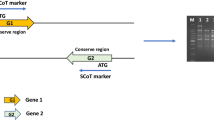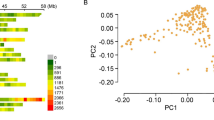Abstract
In recent years, the production costs of cotton (Gossypium hirsutum L.) in China have continued to rise, and this has been accompanied by relatively low productivity, diminished enthusiasm of Chinese farmers for planting cotton, and the difficulty caused by high subsidies as well as the high degree of mechanized harvesting for competing crops like grains. Therefore, it is urgent to improve the level of mechanization and the scale of cotton production in China. Morphological traits play an important role in the mechanized harvesting of cotton. Plant height (PH), height of the first fruiting branch node (HFFBN), and the number of vegetative shoot (NOVS) are key cotton morphological traits that influence mechanical harvesting. The genetic basis of PH, HFFBN, and NOVS were examined in the Z571 and CCRI 49 parents as well as 188 individuals comprising the F2 mapping population. This F2 population was examined using genotyping by sequencing (GBS) with 5571 high-density polymorphism single nucleotide polymorphism (SNP) markers to construct a genetic linkage map comprised of 3187 polymorphic markers. The genetic map spanned 3828.551 cM, with an average distance of 0.687 cM between markers. The complete interval mapping method identified 17 quantitative trait loci (QTL) for PH, HFFBN, and NOVS located on chromosomes 3, 4, 5, 7, 9, 17, 19, 23, and 25. Our study provides an efficient approach for fast detection of QTL underlying complex trait variation with high accuracy, thus providing preliminary information that can improve the efficiency of subsequent machine cotton picking through breeding and molecular marker-assisted selection methods.








Similar content being viewed by others
References
Adawy SS, Diab AA, Atia MA, Hussein EH (2013) Construction of genetic linkage map with chromosomal assignment and quantitative trait loci associated with some important agronomic traits in cotton. GM Crops Food 1:36–49
Chen Z, Wang B, Dong X, Liu H, Ren L, Chen J et al (2014) An ultra-high density bin-map for rapid QTL mapping for tassel and ear architecture in a large F2 maize population. BMC Genomics 15:433
Chen W, Yao J, Chu L, Yuan Z, Li Y, Zhang Y (2015) Genetic mapping of the nulliplex branch gene (gb_nb1) in cotton using next generation sequencing. Theor Appl Genet 3:539–547
Elshire RJ, Glaubitz JC, Sun Q, Poland JA, Kawamoto K, Buckler ES et al (2011) A robust, simple genotyping-by-sequencing (GBS) approach for high diversity species. PLoS ONE 5:e19379
Guajardo V, Solís S, Sagredo B, Gainza F, Muñoz C, Gasic K et al (2015) Construction of high density sweet cherry (Prunus avium L.) linkage maps using microsatellite markers and SNPs detected by genotyping-by-sequencing (GBS). PLoS ONE 5:e0127750
Jamshed M, Jia F, Gong J, Koffi K, Shi Y, Li J et al (2016) Identification of stable quantitative trait loci (QTLs) for fiber quality traits across multiple environments in Gossypium hirsutum recombinant inbred line population. BMC Genomics 17:197
Jiang X, Li H, Wang T, Peng C, Wang H, Wu H et al (2012) Gibberellin indirectly promotes chloroplast biogenesis as a means to maintain the chloroplast population of expanded cells. Plant J 5:768–780
Jiang B, Liu W, Xie D, Peng Q, He X, Lin Y et al (2015) High-density genetic map construction and gene mapping of pericarp color in wax gourd using specific-locus amplified fragment (SLAF) sequencing. BMC Genomics 16:1035
Kosambi DD (1944) The estimation of map distances from recombination values. Ann Eugen 12:172–175
Li H, Durbin R (2009) Fast and accurate short read alignment with Burrows-Wheeler transform. Bioinformatics 14:1754–1760
Li H, Handsaker B, Wysoker A, Fennell T, Ruan J, Homer N et al (2009) The sequence alignment/map format and SAMtools. Bioinformatics 16:2078–2079
Li CQ, Wang QL, Dong N, Fu YZ, Zhang JB, Lian XD (2010) Quantitative inheritance for main plant architecture traits of upland cotton variety Baimian 1. Cotton Sci 22:415–421
Li C, Wang X, Dong N, Zhao H, Xia Z, Wang R et al (2013) QTL analysis for early-maturing traits in cotton using two upland cotton (Gossypium hirsutum L.) crosses. Breed Sci 2:154–163
Li F, Fan G, Wang K, Sun F, Yuan Y, Song G et al (2014) Genome sequence of the cultivated cotton Gossypium arboreum. Nat Genet 6:567–572
Li F, Fan G, Lu C, Xiao G, Zou C, Kohel RJ et al (2015) Genome sequence of cultivated Upland cotton (Gossypium hirsutum TM-1) provides insights into genome evolution. Nat Biotechnol 5:524–530
Liu D, Liu F, Shan X, Zhang J, Tang S, Fang X et al (2015) Construction of a high-density genetic map and lint percentage and cottonseed nutrient trait QTL identification in upland cotton (Gossypium hirsutum L.). Mol Genet Genomics 5:1683–1700
Luan M, Guo X, Zhang Y, Yao J, Chen W (2009) QTL mapping for agronomic and fibre traits using two interspecific chromosome substitution lines of Upland cotton. Plant Breed 128:671–679
Mathew LS, Spannagl M, Al-Malki A, George B, Torres MF, Al-Dous EK et al (2014) A first genetic map of date palm (Phoenix dactylifera) reveals long-range genome structure conservation in the palms. BMC Genomics 15:285
McKenna A, Hanna M, Banks E, Sivachenko A, Cibulskis K, Kernytsky A et al (2010) The genome Analysis Toolkit: a MapReduce framework for analyzing next-generation DNA sequencing data. Genome Res 9:1297–1303
Mei YJ, Yu JW, Xue AL, Fan SL, Song MZ, Pang CY et al (2016) Association mapping of genetic network for plant morphological traits in cotton. J Zhejiang Univ 2:127–136
Nie X, Tu J, Wang B, Zhou X, Lin Z (2015) A BIL population derived from G. hirsutum and G. barbadense provides a resource for cotton genetics and breeding. PLoS ONE 10:e0141064
Nusurat O, Yu SX, Fan SL, Pang CY (2012) Correlation of agronomic characters and QTL mapping in mechanical harvest cotton (Gossypum hirsutum L.). Xinjiang Agric Sci 5:791–795
Okogbenin E, Fregene M (2003) Genetic mapping of QTLs affecting productivity and plant architecture in a full-sib cross from non-inbred parents in Cassava (Manihot esculenta Crantz). Theor Appl Genet 8:1452–1462
Reihardt D (2002) Kuhlemerier C. Plant architecture. EMBO Rep 9:846–851
Sakamoto T, Matsuoka M (2004) Generating high-yielding varieties by genetic manipulation of plant architecture. Curr Opin Biotechnol 2:144–147
Shang LG, Liu F, Wang YM, Abduweli A, Cai SH, Wang KB et al (2015) Dynamic QTL mapping for plant height in upland cotton (Gossypium hirsutum). Plant Breed 134:703–712
Song GL, Cui RX, Wang KB, Guo LP, Li SH, Wang CY (1998) A rapid improved CTAB method for extraction of cotton genomic DNA. Cotton Sci 5:273–275
Soto JC, Ortiz JF, Perlaza-Jiménez L, Vásquez AX, Lopez-Lavalle LA, Mathew B et al (2015) A genetic map of cassava (Manihot esculenta Crantz) with integrated physical mapping of immunity-related genes. BMC Genomics 16:190
Van Ooijen JW (2006) JoinMap 4® Software for the calculation of genetic linkage maps in experimental populations. Wageningen, The Netherland 56 p
Van Ooijen JW (2009) Map QTL 6. Software for the mapping of quantitative trait loci in experimental populations of diploid species. Kyazma BV: Wageningen, Netherlands. https://www.kyazma.nl/index.php/mc.MapQTL/
Wang Y, Li J (2008) Molecular basis of plant architecture. Annu Rev Plant Biol 59:253–279
Wang BH, Wu YT, Huang NT, Zhu XF, Guo WZ, Zhang TZ (2006) QTL mapping for plant architecture traits in upland cotton using RILs and SSR markers. Yi Chuan Xue Bao 2:161–170
Wang S, Basten C, Zeng Z (2007) Windows QTL Cartographer 2.5. Department of Statistics, North Carolina State University, Raleigh. http://statgen.ncsu.edu/qtlcart/WQTLCart.htm
Wang K, Wang Z, Li F, Ye W, Wang J, Song G et al (2012) The draft genome of a diploid cotton Gossypium raimondii. Nat Genet 10:1098–1103
Wang S, Chen J, Zhang W, Hu Y, Chang L, Fang L et al (2015) Sequence-based ultra-dense genetic and physical maps reveal structural variations. Genome Biol 16:108
Wu Y, Fu Y, Zhao S, Gu P, Zhu Z, Sun C et al (2016) CLUSTERED PRIMARY BRANCH 1, a new allele of DWARF11, controls panicle architecture and seed size inrice. Plant Biotechnol J 1:377–386
Xiao Sh, Wu QJ, Liu JG, Chen XS, Xu NY, Di JC et al (2010) Study on ideal plant type of cotton cultivar for mechanical cultivation and harvest. Acta Agric Jiangxi 228:1–4
Yang X, Wang Y, Zhang G, Wang X, Wu L, Ke H et al (2016) Detection and validation of one stable fiber strength QTL on c9 in tetraploid cotton. Mol Genet Genomics 4:1625–1638
Yu SX, Zhang L, Feng WJ (2015) Easy and enjoyable cotton cultivation: developments in China’s cotton production. Cotton Sci 3:283–290
Yu SX, Zhang L, Feng WJ (2016) Study on strategy of large scale, mechanization, informationization, intelligence and social services for cotton production. Eng Sci 1:137–148
Zhai H, Gong W, Tan Y, Liu A, Song W, Li J et al (2016) Identification of chromosome segment substitution lines ofGossypium barbadense introgressed in G. hirsutum and quantitative trait locus mapping forfiberquality and yield traits. PLoS ONE 9:e0159101
Zhang T, Hu Y, Jiang W, Fang L, Guan X, Chen J et al (2015a) Sequencing of allotetraploid cotton (Gossypium hirsutum L. acc. TM–1) provides a resource for fiber improvement. Nat Biotechnol 5:531–537
Zhang J, Yu J, Pei W, Li X, Said J, Song M et al (2015b) Genetic analysis of Verticillium wilt resistance in a backcross inbred line population and a meta-analysis of quantitative trait loci for disease resistance in cotton. BMC Genomics 16:577
Zhang Z, Shang H, Shi Y, Huang L, Li J, Ge Q et al (2016) Construction of a high-density genetic map by specific locus amplified fragment sequencing (SLAF-seq) and its application to Quantitative Trait Loci (QTL) analysis for boll weight in uplandcotton (Gossypiumhirsutum.). BMC Plant Biol 16:79
Zhao L, Lv YD, Cai CP, Tong XC, Chen XD, Zhang W et al (2012) Toward allotetraploid cotton genome assembly: integration of a high-density molecular genetic linkage map with DNA sequence information. BMC Genomics 13:539
Zhou G, Chen Y, Yao W, Zhang C, Xie W, Hua J et al (2012) Genetic composition of yield heterosis in an elite rice hybrid. Proc Natl Acad Sci USA 109(39):15847–15852
Zhou ZQ, Zhang CS, Zhou Y, Hao ZF, Wang ZH, Zeng X et al (2016) Genetic dissection of maize plant architecture with an ultra-high density bin map based on recombinant inbred lines. BMC Genomics 17:178
Acknowledgements
This work was supported by the Basic Scientific Research Budget Increment Project of the Chinese Academy of Agricultural Sciences (1610162016Y02), the National Science and Technology Support Program (2014BAD03B03), and the Science and Technology Innovation Project of the Chinese Academy of Agricultural Sciences, the Modern Agricultural Industry Technology System in Henan (No. S2013-07-1), and the China Agricultural Research System (No. CARS-18-05).
Author contribution
Conceived and designed the experiments: GTY, QH. Performed the experiments: HKQ, NW, QH, WQQ. Analyzed the data: HKQ, GTY, QH, JBS. Contributed reagents/materials/analysis tools: NW/HZ/QHX. Wrote the paper: HKQ, QH, GTY. Final approval of the version to be published: QH, GTY.
Author information
Authors and Affiliations
Corresponding authors
Additional information
Haikun Qi and Ning Wang have contributed equally to this work.
Electronic supplementary material
Below is the link to the electronic supplementary material.
Rights and permissions
About this article
Cite this article
Qi, H., Wang, N., Qiao, W. et al. Construction of a high-density genetic map using genotyping by sequencing (GBS) for quantitative trait loci (QTL) analysis of three plant morphological traits in upland cotton (Gossypium hirsutum L.). Euphytica 213, 83 (2017). https://doi.org/10.1007/s10681-017-1867-7
Received:
Accepted:
Published:
DOI: https://doi.org/10.1007/s10681-017-1867-7




